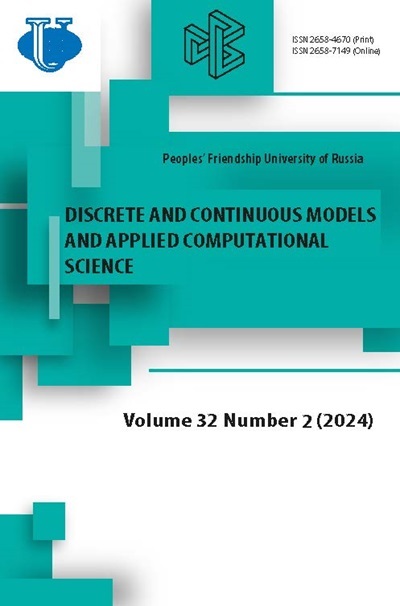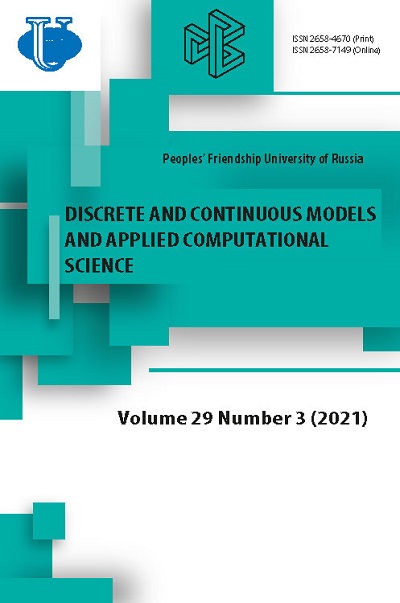Оценка влияния межсетевого экрана на инициирование сеанса по мультимедийному протоколу SIP
- Авторы: Ботвинко А.Ю.1, Самуйлов К.Е.1,2
-
Учреждения:
- Российский университет дружбы народов
- Федеральный исследовательский центр «Информатика и управление» РАН
- Выпуск: Том 29, № 3 (2021)
- Страницы: 221-229
- Раздел: Статьи
- URL: https://journals.rudn.ru/miph/article/view/27526
- DOI: https://doi.org/10.22363/2658-4670-2021-29-3-221-229
Цитировать
Полный текст
Аннотация
Межсетевые экраны - один из основных компонентов обеспечения сетевой безопасности. Используя межсетевые экраны, можно решить такие проблемы, как предотвращение несанкционированного доступа, а также удаление, изменение и/или распространение информации, находящейся под защитой. Процесс фильтрации информационных потоков межсетевым экраном вносит дополнительные задержки по времени, что может привести к нарушению стабильной работы защищаемой автоматизированной системы или недоступности сервисов, предоставляемых системой. Мультимедийные услуги особенно чувствительны к задержкам обслуживания. Основная цель исследования, представленного в статье, - оценить влияние межсетевого экрана на временные задержки в процессе передачи данных в автоматизированной системе с протоколами передачи мультимедийных данных. Оценка обеспечивается методами теории очередей, в то время как сеанс между двумя пользователями инициируется протоколом инициации сеанса (SIP) с фильтрацией сообщений межсетевого экрана. Межсетевой экран - это локальный или функциональный инструмент распределения, который обеспечивает контроль над входящей и/или исходящей информацией в автоматизированной системе (AS) и защиту системы путем фильтрации информации, т.e. гарантирует возможность анализа информации по заданным критериям и принятие решения о её распространении.
Ключевые слова
Об авторах
А. Ю. Ботвинко
Российский университет дружбы народов
Автор, ответственный за переписку.
Email: botviay@sci.pfu.edu.ru
ORCID iD: 0000-0003-1412-981X
postgraduate of Department of Applied Probability and Informatics
ул. Миклухо-Маклая, д. 6, Москва, 117198, РоссияК. Е. Самуйлов
Российский университет дружбы народов; Федеральный исследовательский центр «Информатика и управление» РАН
Email: samuylov-ke@rudn.ru
ORCID iD: 0000-0002-6368-9680
Doctor of Technical Sciences, Professor, Head of Department of Applied Probability and Informatics
ул. Миклухо-Маклая, д. 6, Москва, 117198, Россия; ул. Вавилова, д. 44, корп. 2, Москва, 119333, РоссияСписок литературы
- “Recommendation ITU T G.107. The E model: a computational model for use in transmission planning. Series G: Transmission Systems And Media, Digital Systems And Networks International Telephone Connections And Circuits - Transmission Planning And the E-model,” approved in 2015-06-29.
- J. Rosenberg, H. Schulzrinne, G. Camarillo, et al., “RFC 3261 SIP: Session Initiation Protocol,” 2002.
- A. Johnston, S. Donovan, R. Sparks, et al., “RFC 3665 SIP. Session Initiation Protocol (SIP) Basic Call Flow Examples,” 2003.
- A. B. Goldstein and B. S. Goldstein, Softswitch. Saint Petersburg: BHV Publishing House Petersburg, 2006, p. 368.
- D. Malas and A. Morton, “RFC 6076. Basic Telephony SIP End to End Performance Metrics,” 2011.
- K. V. Ivanov and P. I. Tutubalin, Markov models of protection of automated control systems for special purposes [Markovskie modeli zashhity’ avtomatizirovanny’x sistem upravleniya special’nogo naznacheniya]. Kazan: Publishing house of GBU Republican center for monitoring the quality of education Publ., 2012, p. 216, in Russian.
- F. Baskett, K. M. Chandy, R. R. Muntz, and F. G. Palacios, “Open, closed and mixed networks of queues with different classes of customers,” Journal of the ACM, pp. 248-260, 1975. doi: 10.1145/321879.321887.
- K. E. Samouylov, M. V. Luzgachev, and O. N. Plaksina, “Modelling SIP Connections with Open Multiclass Queueing Networks [Razrabotka veroyatnostnoj modeli dlya analiza pokazatelej kachestva protokola iniciirovaniya seansov svyazi],” Bulletin of Peoples’ Friendship University of Russia. Series Mathematics. Information Sciences. Physics, no. 3, pp. 53-63, 2007, in Russian.
- Y. V. Gaidamaka and E. R. Zaripova, “Session Setup Delay Estimation Methods for IMS Based IPTV Services,” Lecture Notes in Computer Science, vol. 8638, pp. 408-418, 2014. doi: 10.1007/978-3-319-103532_36.
- V. M. Vishnevsky, Polling systems: theory and application in broadband wireless networks [Sistemy pollinga: teoriya i primenenie v shirokopolosnyh besprovodnyh setyah]. Moscow: Technosphere Publishing House, 2007, p. 312, in Russian.
- Ali Raad Abdo Mohammed, “Development of a method for evaluating the probabilistic and temporal characteristics of IPTV services when they are controlled by the IMS multimedia subsystem [Razrabotka metoda otsenki veroyatnostno-vremennykh kharakteristik uslug IPTV pri ikh upravlenii mul’timediynoy podsistemoy IMS],” in Russian, Ph.D. dissertation, Moscow technical university of communications and informatics, 2013.
- K. E. Samouylov, Methods of analysis and calculation of ACS networks [Metody analiza i rascheta setey OKS]. Moscow: Publishing RUDN, 2002, p. 292, in Russian.
- I. Buzyukova, Y. Gaidamaka, and G. Yanovsky, “Estimation of QoS parameters in intelligent network,” Lecture Notes in Computer Science, vol. 5764, pp. 143-153, 2009. doi: 10.1007/978-3-642-04190-7_14.
- K. E. Samouylov, E. S. Sopin, A. V. Chukarin, and A. Y. Botvinko, “Evaluation of the characteristics of signal traffic in the communication network based on the subsystem [Ocenka harakteristik signal’nogo trafika v seti svyazi na baze podsistemy],” T-Comm - Telecommunications and Transport, no. 7, pp. 8-13, 2010, in Russian.
- “Recommendation ITU T Y.1530. Call processing performance for voice service in hybrid IP networks. Series y: global information infrastructure, internet protocol aspects and next generation networks internet protocol aspects and next-generation networks,” approved in 2007-11-13.
- “Recommendation ITU T Y.1531. SIP based call processing performance. Series Y: Global Information Infrastructure, Internet Protocol Aspects And Next Generation Networks Internet Protocol Aspects - Quality Of Service And Network Performance,” approved in 2007-11-13.
- “Recommendation ITU T Y.1541. Network performance objectives for IP based services. Series y: global information infrastructure, internet protocol aspects and next generation networks internet protocol aspects - quality of service and network performance,” approved in 2011-12-14.
- “DSL Forum, Technical Report-126, Triple-play Services Quality of Experience (QoE) Requirements,” 2006.
















